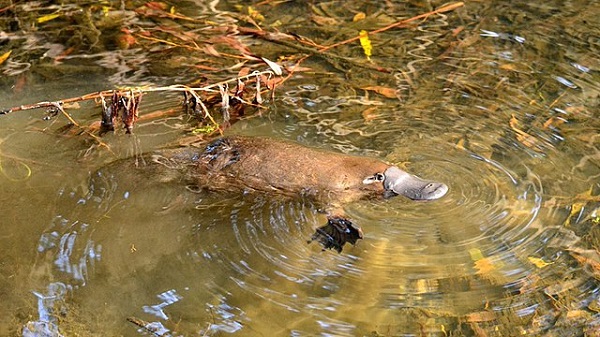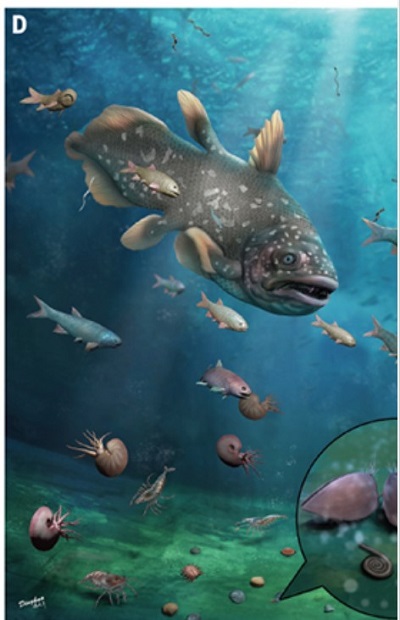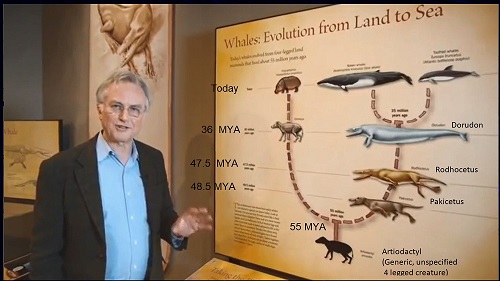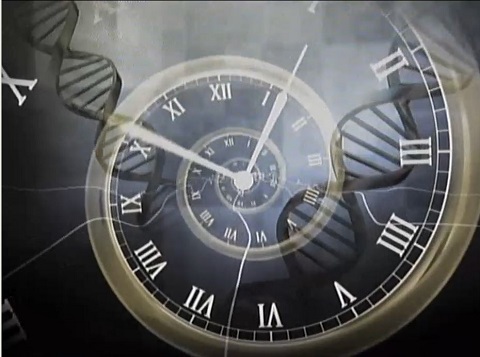|
Question Evolution Day 2023
Here
we are at another February 12th,
Question Evolution Day, where instead of presenting evidence for
creation, we offer creation skeptics an opportunity to check their
intellectual freedom and integrity.
An opportunity to see if they
are slaves to the evolutionary dogma, or if they have the intellectual
freedom and integrity to seriously consider the many challenges to
Darwinian Evolution. An opportunity to observe that Darwinian Evolution
is not only internally inconsistent, but the evidence does not support
it; the evidence supports creation.
Today we're running a two for one special. Thanks to one of my creation compadres who sent me a link to an interesting article just in time for Question Evolution Day, I thought I'd add it to the offering I had already intended to present. So for this year, we'll present two challenges to the evolutionary dogma. First up: the platypus
The Platypus
One of the first things noted about this creature, often called
the duck-billed platypus, is how strange it is due to its unique
mixture of features from many different animal types. It is so strange
that, "when the first platypus specimen reached England in 1799 (it was
long dead), it was regarded as a hoax, a [1] ‘high frolic practised on
the scientific community by some colonial prankster’.[2] One zoologist who thought the
duckbilled had been sewed on tried to pry it off with scissors. And no wonder
they considered the unknown creature a hoax. Consider its features:
- Fur like most mammals
- a bill like a duck
- a flat tail like a beaver
- Webbed feed in front for swimming
- Otter like feet in back
- Venom - while both males and females have spurs on their feet, the males have sharp poisonous ones of their hind feet, which deliver various venoms, three of which are unique to the platypus
- Biofluorescence -
In 2020, research in biofluorescence revealed that
the platypus glows a bluish-green color when exposed to
Black light[3]
And that's just their bodily features. Consider their behaviors:
-
Females lay reptile-like eggs, then find the young to suckle them.
-
Milk is not produced through teats, but sucked through the skin
-
Claws used for burring
-
Though thought to be primitive, it was discovered the platypus uses electrolocation to find food- they can detect faint electric fields put out by it's favorite food - shrimp.

Platypus electrolocation. Its electroreceptors are arranged on its bill.
It moves
the bill from side to side in saccades, quick head movements, as it
swims,
so as to locate small electrical signals from its prey as accurately as
possible.[4]
The differences are not only to the external appearances and features. Dr Rob Carter points out a number "chimeric features"[5] found in the platypus genome that include:
- Reptile-like features
- Bird-like features
- Mammal-like features
- Marsupial-like features
Questions for evolutionists regarding the duck-billed platypus:
Darwinian evolution states that all life on earth evolved from a single common
ancestor. This is depicted by what is referred to as the "tree of life."
Supposedly all creatures evolved from a "last universal common ancester"
(LUCA)
- branching out as they differentiate to different families and species.
Below is the "tree of life" as depicted
at the Milwaukee Public Museum.
On this picture you'll note I've highlighted in red boxes four different
branches which represent the families of the different features
exhibited by the platypus as noted by Rob Carter above.
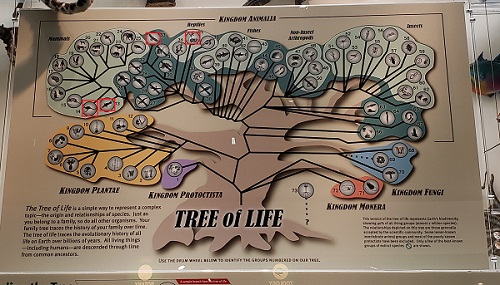
Notice those families - platypus,
marsupials, birds and reptiles are found on different branches of the
evolutionary tree. Now here's the question: How can one creature - the
platypus evolve from four different families in different branches on
the evolutionary tree?
If you want to claim the platypus
evolved all those features by itself along its own family line, using
the standard beneficial mutations, selection and millions of years of
time non-sense, then you have an even bigger problem: Where do you get
the genetic information to build the new features? The mutations +
selection + time mantra won't work. Because as geneticist John C.
Sanford points out:
"It has long been thought that since beneficial mutations happen and
since natural selection happens, continuously increasing biological
information should be inevitable. This paper shows that this oft-voiced
historical perspective was naïve. Not only are there too few beneficial
mutations for genome-building, but most of the information in higher
genomes is encoded by nucleotides which individually are two subtle to
have been selectively established. The few truly beneficial mutations
that arise and have sufficient impact to be selectively amplified only
arise independently and in isolation. This profoundly limits their
potential impact. They can only accomplish fine-tuning of
pre-existing biological information. Realistically, genomes cannot
be built one beneficial mutation at a time."[6](emphasis mine)
In other words, beneficial mutations can only enhance qualities that are already existing, (by eliminating information as demonstrated elsewhere[7]) they cannot create new features or information. So it is impossible for the platypus to have evolved those features on its own isolated line.
Confirmed Again - this time with Fish:
Evolution Simply does not happen
An article in Science Magazine confirms
(perhaps unwittingly) that evolution simply does not happen. The article
is titled "A
Mesozoic fossil lagerstätte from 250.8 million years ago shows a
modern-type marine ecosystem." A "lagerstätte" is a "finely
preserved fossil assemblages", and
the
mesozoic era runs from about 230 to 62 million years ago - in
evolutionary reckoning. The paper reports:
"Here, we report an exceptionally preserved fossil assemblage named
Guiyang Biota from Guizhou Province, South China, which is late
Dienerian in age (~1 Myr after the PTME [Permian-Triassic mass
extinction]) and is therefore the oldest known Mesozoic fossil
lagerstätte. The Guiyang Biota represents a diverse and trophically
complex marine ecosystem and partially fills the 3-Myr gap of complex
marine faunas, indicating a rapid rise of modern-type marine
ecosystems after the PTME despite global sea-surface temperatures
remaining high." [emphasis mine]
So essentially this paper is saying they're finding modern looking creatures in early time periods where they're not expected. Here is an artist conception of the life in the referenced ecosystem during the stated time period included with the article:
Notice the coelacanth prominently featured. Coelacanths were of course
were thought have gone extinct some 350 million years ago. Until
they found live groups of them living near places like Madagascar in the Indian
ocean.
Of course that is just another one of the many, many embarrassments that evolutionists must suffer since the facts are continuing to disprove this laughably false theory. But that's not the question. The question concerns the fact that they see no evolution happening in 250 million years - they found "modern-type" marine specimens.
That is a shockingly long time for no evolution to be happening
especially when you consider:
Primates were on the scene 10,000,000 years ago.
Modern humans were on the scene merely 200,000 years ago - so 9.8
million years of evolution supposedly allowed development from primate
to modern human.
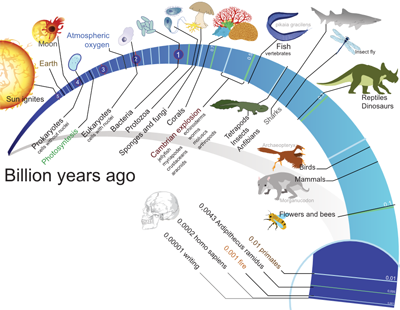
Or consider whales -
From an unknown 4 legged land creature abstracted as an artiodactyl, to a
full sized ocean going
whale took only 19 million years according to Richard Dawkins.
And now they want us to believe that over 250 million years of evolution, nothing changed for the creatures represented in these fossils! Even more unbelievable is the fact that evolutionists believe that evolution is unstoppable, happening at regular, consistent, measurable pace. They believe that using what they call a "molecular clock" they can suppose they can measure the rate of mutations, and hus determine how much time passed between two creatures who supposedly shared a common ancestor as geneticist Mark Stoneking explains in the video below.[8] (Georgia Purdom points out problems with the molecular clock, which like radiometric dating is full of assumptions that make the method unreliable, but I won't consider that problem here.)
So mutations are supposed to be happening unrelentingly at a measurable
rate. Mutations + selection + Big time is supposed to equal evolutionary
changes - even large scale changes - whatever change is necessary for
the evolutionary story - from pond scum to primate or molecules to man.
Evolutionists tell us modern humans evolved from primates in about 9.8 million years, and whales from a four legged creature in 19 million
years. But in 250 million years, there's not a single change in
creatures like the coelacanth and other creatures in its "lagerstätte."
So here's the question:
How can there be no changes in creatures like the coelacanth and other
fish in the Guiyang Biota over 250 million years, when humans supposedly
evolved from primates in 9.8 million years, and whales supposedly evolved from a
four legged land creatures in 19 millions, and evolution is supposedly
happening at a steady, measurable rate as is putatively demonstrated by
the molecular clock?
Now here's the fun part. Evolutionists make up stories in a futile attempt to answer the questions. None of the answers will fit both the evolutionary story telling and the known, demonstrable facts, but before you get tired of hearing the misdirections, strawman arguments, misunderstandings, outright deceptions, and other fallacies, the evolution stories - if creative - can be briefly amusing.
Duane Caldwell | February 11, 2022
Follow @rational_faith_
Notes
1. Paula Weston, "The Platypus", Creation.com, https://creation.com/the-platypus publised in
Creation 24(2):40–43, March 2002Back
2.
Moyal, A., Platypus, Allen and Unwin, New South Wales, Australia, p. xii, 2001.Back
3. "Platypus", Wikipedia,
accessed 11 Feb 2023,
https://en.wikipedia.org/wiki/Platypus
Back
4.
Chiswick Chap (graphics); File:Wild Platypus 4 (cropped).jpg (background image),
CC BY-SA 4., via
Wikimedia Commons
Back
5.
Robert Carter, "Platypus thumbs its nose (or bill) at evolutionary scientists",
Creation.com, accessed 11 Feb 2023,
https://creation.com/platypus-thumbs-its-nose-or-bill-at-evolutionary-scientists
Back
6.
John C. Sanford, Biological Information, New Perspectives, Waterloo NY:
FMS Publications, 2013, p. 19
(summarizing paper: "Selection Threshold Severyly Constrains Capture of
Beneficial Mutations" by John C. Sanford, John R, Baumgardner and Wesley H.
Brewer
Back
7.
For beneficial outcomes resulting from a loss of genetic information see the
paper:
"Getting There First: An Evolution Rate Advantage for Adaptive Loss-of-Function
Mutations" by Michael J. Behe in: John C. Sanford, Biological Information,
New Perspectives, Waterloo NY: FMS Publications, 2013, p. 24
Back
Back
Images
Featured: Wild Platypus, Klaus, CC BY-SA 2.0 via Wikimedia Commons
